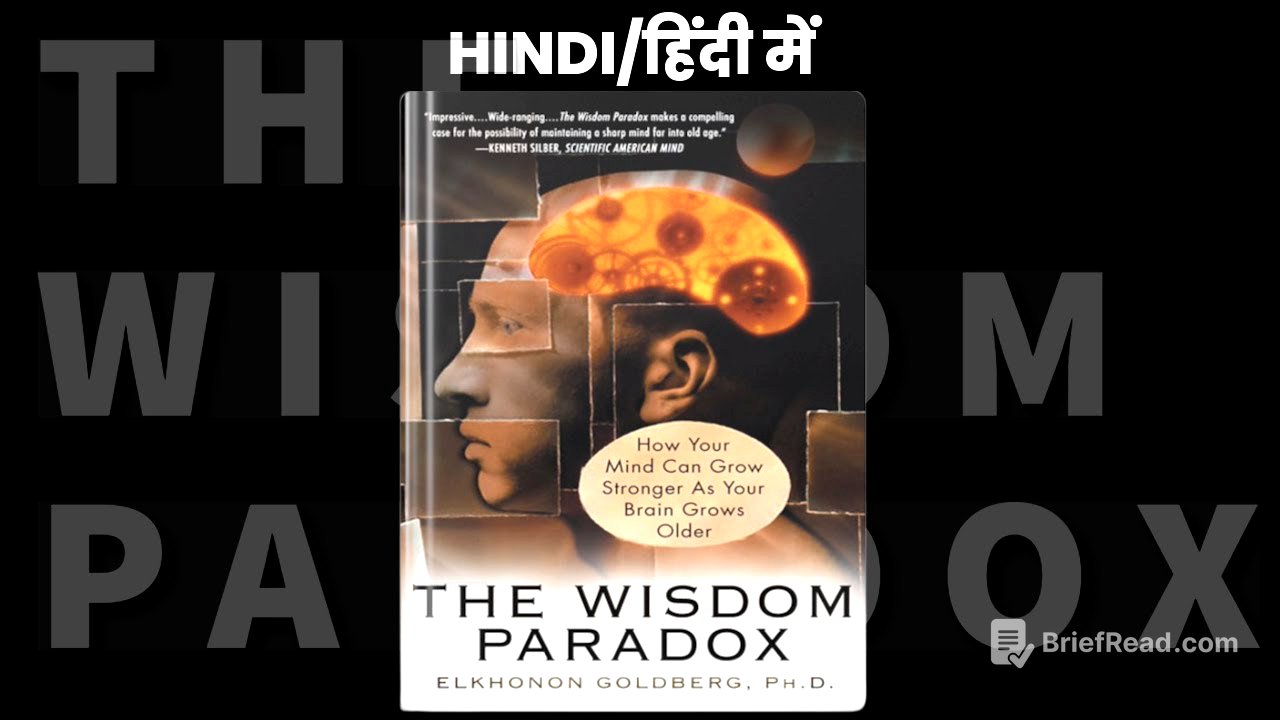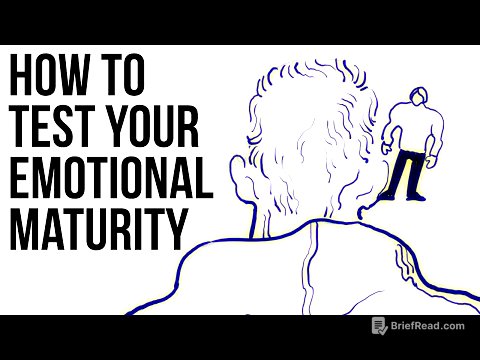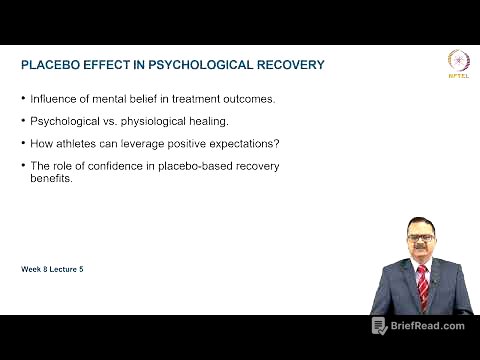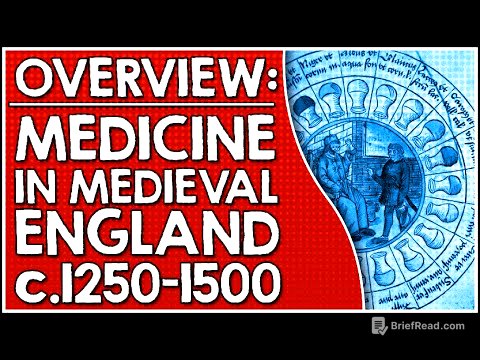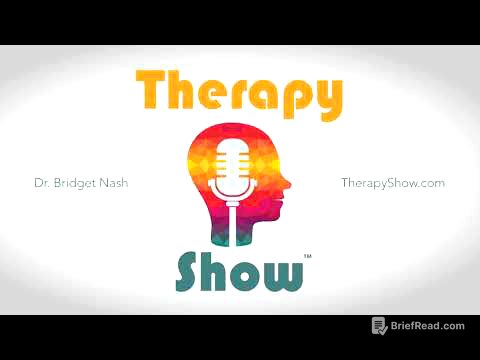TLDR;
This video summarizes "The Wisdom Paradox: How Your Mind Can Grow Stronger As Your Brain Grows Older" by Elkhonon Goldberg. The book explores how the brain ages and how wisdom can increase with age, focusing on neuroscience and cognitive abilities. It challenges negative perceptions of aging and highlights the potential for mental sharpness and growth in later years.
- The book explores the concept of wisdom as a product of pattern recognition and experience.
- It discusses the roles of different brain regions, particularly the frontal lobes, in decision-making and cognitive functions.
- The video touches on the duality of the brain, with the left hemisphere associated with routines and the right with novelty.
- It emphasizes the importance of lifelong learning and mental activity for maintaining brain health and cognitive abilities.
Introduction [0:00]
The book "The Wisdom Paradox" offers a positive perspective on aging, suggesting that cognitive decline can be prevented and mental sharpness can increase with age. It emphasizes the benefits of reading and maintaining an active mind, highlighting that intuition and thinking abilities can improve as one gets older. The book differentiates between mental decline caused by disease and normal aging, motivating readers to embrace aging gracefully and recognizing the potential for continued growth and achievement.
Chapter 1 - THE LIFE OF YOUR BRAIN [23:34]
The chapter addresses the common misconception that the mind and brain are separate entities, asserting that every aspect of mental activity is linked to the brain. It challenges the notion that aging is solely associated with mental decline, arguing that the brain gains unique strengths with age, such as expertise, competence, and wisdom. The chapter introduces the concept of pattern recognition as a key component of wisdom, where the brain uses established patterns to solve problems efficiently.
Chapter 2 - SEASONS OF THE BRAIN [38:54]
The chapter describes the three seasons of the brain: development, maturity, and aging. During development, the brain establishes its basic functions, with neurons forming connections and pruning unnecessary ones. Maturity brings stability as the brain focuses on work and creation. Aging involves changes like decreased brain size and blood flow, but also the potential for cognitive expertise. The prefrontal cortex is particularly vulnerable to aging, affecting planning and complex behavior.
Chapter 3 - AGING AND POWERFUL MINDS IN HISTORY [52:58]
This chapter discusses how older people play a vital role in society by passing on their knowledge and experience. It highlights examples of individuals who achieved great success in their later years, such as Goethe and Golda Meir, and those who continued to contribute significantly despite cognitive decline. The chapter introduces the concept of "eroding yet powerful minds," where individuals with dementia can still make valuable contributions due to their established pattern recognition abilities.
Chapter 4 - WISDOM THROUGHOUT CIVILIZATIONS [57:26]
The chapter explores the concept of wisdom across different cultures and throughout history, noting its consistent recognition as a valuable trait. It discusses the perspectives of philosophers, psychologists, and scientists on wisdom, as well as its connection to genius, talent, and expertise. The chapter defines talent as creativity and novelty, while competence involves linking new problems to old ones to find solutions.
Chapter 5 - PATTERN POWER [1:09:55]
Pattern recognition is the brain's ability to relate new objects or problems to previously seen ones, which is crucial for problem-solving. Some patterns are innate, while others are learned through experience and culture. Language is a key tool for pattern recognition, enabling humans to categorize and understand the world. Wisdom involves not just identifying patterns but also knowing what actions to take based on them.
Chapter 6 - ADVENTURES ON MEMORY LANE [1:22:37]
The chapter discusses the importance of memory in developing wisdom, particularly generic memory, which involves memories linked to patterns. It explains how memories are formed through sensory organs and higher brain processes, with new proteins and synapses created. The chapter also differentiates between anterograde and retrograde amnesia, noting that new memories are typically lost first in brain damage.
Chapter 7 - MEMORIES THAT DO NOT FADE [1:36:33]
Generic memories, which are memories with patterns, are more stable and less likely to fade, even with brain damage. These memories are formed through repetition and are stored in the neocortex. The chapter also discusses procedural and declarative memory, as well as episodic and semantic memory, noting that specific facts are quickly forgotten while generic memories persist.
Chapter 8 - MEMORIES, PATTERNS, AND THE MACHINERY OF WISDOM [1:52:48]
Wisdom involves pattern recognition, where the brain uses established patterns to quickly identify and solve problems. Intuition, which increases with age, is the essence of past experiences stored in the mind. The chapter also differentiates between descriptive knowledge (the way things are) and prescriptive knowledge (what should be done), noting that prescriptive knowledge is stored in the frontal lobes.
Chapter 9 - “UP-FRONT” DECISION-MAKING [1:59:38]
The frontal lobes, particularly the prefrontal cortex, are crucial for thinking, planning, and decision-making. These lobes act as a conductor, organizing the rest of the brain. The chapter discusses the importance of prescriptive knowledge and executive functions, such as planning and problem-solving. The frontal lobes also play a role in moral development, empathy, and understanding cause and effect.
Chapter 10 - NOVELTY, ROUTINES, AND TWO SIDES OF THE BRAIN [2:11:46]
The chapter explores the duality of the brain, with the left hemisphere handling routines and the right hemisphere exploring new things. It discusses how the control of the mind gradually shifts from the right to the left hemisphere as cognitive development progresses. The chapter also notes structural and biochemical differences between the two hemispheres.
Chapter 11 - BRAIN DUALITY IN ACTION [2:24:40]
The chapter provides evidence supporting the theory that the right hemisphere is more active when learning new things, while the left hemisphere takes control as tasks become routine. It discusses how this shift in cognitive control from right to left continues throughout life. The chapter also notes that the left hemisphere is more active in language tasks, while the right hemisphere is more involved in visual tasks.
Chapter 12 - MAGELLAN ON PROZAC [2:38:56]
The chapter discusses the role of emotions in the brain, noting that the left hemisphere is associated with positive emotions, while the right hemisphere is associated with negative emotions. It explores how this division of emotional processing affects creativity and exploration, suggesting that a certain level of inner restlessness or dissatisfaction can fuel the desire to discover new things.
Chapter 13 - THE DOG DAYS OF SUMMER [2:54:50]
The chapter addresses how aging affects both parts of the brain, noting that the right hemisphere tends to weaken faster than the left. It presents evidence from various studies showing that the right hemisphere experiences more atrophy with age. The chapter suggests that this may be due to the left hemisphere being used more frequently throughout life, leading to greater durability.
Chapter 14 - USE YOUR BRAIN AND GET MORE OF IT [3:00:51]
The chapter discusses the concept of neuroplasticity, highlighting that the brain can renew itself with age. It challenges the old idea that no new neurons are formed in the adult brain, presenting evidence that new neurons continue to be formed throughout life. The chapter emphasizes that mental activity can stimulate the formation of new neurons, similar to how exercise grows muscles.
Chapter 15 - PATTERN BOOSTERS [3:09:32]
The chapter emphasizes the importance of keeping the mind active to prevent brain aging. It suggests that cognitive exercises can strengthen the brain, similar to how athletics strengthen the body. The chapter also notes that art engages both the mind and senses, providing a new challenge that keeps the brain fit.
EPILOGUE [3:13:31]
The epilogue reflects on the author's personal experience with brain imaging and the insights gained from writing the book. It emphasizes the importance of using the brain well in youth to build a mental shield for old age. The epilogue also encourages readers to embrace new challenges and maintain mental activity throughout life, recognizing that the journey of the mind is a lifelong pursuit.
